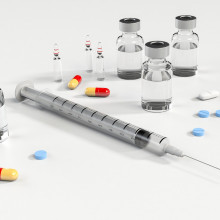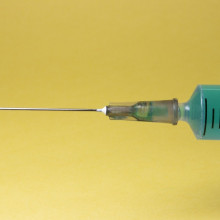Nitazenes move the needle for drug death distress
Today we're investigating dangerous new drugs which have found their way onto the streets of the UK. Nitazenes are lab made opioids with similar effects for the user as heroin. Their relative strength, however, means it is much more difficult to take them safely and much more likely to result in a fatal overdose. With drug deaths in this country already at a record high, and devestation being wrought by similar substances in the US, we look at a range of solutions for preventing as much harm as possible...
In this episode

01:07 - UK drug deaths reach 5,000 per year
UK drug deaths reach 5,000 per year
Peter Furlong from Change, Grow, Live
Peter Furlong works for Change, Grow, Live, a charity which helps people with drug addiction. James Tytko spoke to him about why many are calling the current drug death situation a crisis…
Peter - There are many reasons, really, as we know that people have a relationship with illicit drugs, or even prescription drugs. A lot of the time it's to cope with a lifestyle or trauma from early childhood that has been unresolved, it might be actually a lifestyle choice, people use drugs to maximise the pleasure they get from drugs, and some people may use drugs as part of a recreational pattern as well. Alternatively, it could be dependent use. So there are many reasons why we find that people have relationships with drugs.
James - In terms of what sorts of drugs people you work with are most commonly using and which ones are doing the most harm, could you break that down for me?
Peter - Typically it's your opiate drugs that'll do the most harm in terms of illicit use. I mean, alcohol is the biggest killer in the UK in terms of deaths, but if we're talking about illicit use, illicit drugs, it tends to be opiates and heroin predominantly we're talking about.
James - It must be really difficult when, despite the work you do, there are cases when someone who you've helped, who has a harmful relationship with heroin or other opiates, ends up really hurting themselves.
Peter - Yeah absolutely. The number of drug related deaths now is at the highest they've ever been since records began in the nineties, just under 5,000 people a year now dying from drug related deaths, so that's the ultimate harm, isn't it? Every death is a devastation for a number of people, for a family. It is a life that's lost and many times preventable deaths. Preventable if interventions could have been offered and support.
James - Synthetic opioids are becoming more prevalent on the UK drug market, is that a big worry for the vulnerable people you work with? You mentioned opiates already, and these new synthetic opioids can be even stronger and more dangerous.
Peter - Absolutely. It's a really worrying time in the UK at the moment. It was about 2021 we first experienced the synthetics in the illicit supply. Then it sort of disappeared for a little bit but last year it came back with a vengeance, really. We've seen a lot of drug related deaths, overdose deaths, last year and this year. We're seeing a lot more non-fatal overdoses where synthetics have been involved, primarily nitazenes, which is a synthetic opiate that's being introduced to the illicit supply.

04:46 - What are nitazenes?
What are nitazenes?
Rick Lines, WEDINOS
So, what exactly do we know about these new nitazenes? Rick Lines can help us here, he is the head of substance misuse at Public Health Wales and WEDINOS - which is the biggest public drug testing service in the UK…
Rick - Nitazenes are a group of substances. They're a class of high potency synthetic opioids. They were originally developed by the pharmaceutical industry in the 1950s as analgesics, pain killers, but the clinical development of nitazenes was abandoned because of concerns of adverse effects and harm related to them. So they are an illicit form of substance, and again, a high potency substitute for traditional opiates.
James - Why are synthetic opioids so dangerous to those who use them?
Rick - Well, quite simply because they are much more potent than the traditional opiates that they are used to substitute for. People might be purchasing a substance thinking it is heroin, for example, and in reality be purchasing something that has a much more potent form of synthetic opiate mixed in. So people's breathing, for example, gets incredibly, incredibly shallow. So it's usually linked, although not always, but usually linked to some form of respiratory system suppression.
James - Nitazenes refers to a number of different drugs. They're illegal, as you mentioned. Given these facts, how do you investigate or how does one go about investigating the prevalence of them in the UK drug supply?
Rick - It's very difficult. Probably the most effective way of doing it is obviously to have access to drug checking or drug testing, and we're fortunate that we have the WEDINOS programme here in Wales that is able to do some of that and there are other smaller projects in England, and they're looking to start one up in Scotland. But it's very, very difficult. We're talking about very tiny doses and we accept samples from a range of both partner agencies out in the community, from drug services, from nighttime economy venues, from prison services, from accident and emergency, from homeless hostels and shelters, etc., and we also accept anonymous submissions from the public. They can send in a sample of what they've purchased. WEDINOS works from the perspective that the only way to be a hundred percent sure of your own safety is not to take a substance, but if you are going to take a substance, it obviously increases your safety, decreases your risk of harm, to know what you're taking.
James - And as per your work, what's the scale of the nitazene problem here in the UK?
Rick - WEDINOS as a service does not test overall prevalence. It's a voluntary service, so we're only able to test what is submitted to us. In terms of nitazenes, we received our first sample of a nitazene in April of 2021, so about three years ago. Initially, for the first period of time, we mainly saw nitazenes in samples that were submitted as oxycodone. Leading up to the Christmas period, we were detecting nitazenes in quite a lot of samples that were being sent to us as benzodiazepines, counterfeit pharmaceutical products essentially that were probably being purchased from illicit online pharmacies. This was a concern because you wouldn't necessarily expect to see a synthetic opiate in a benzodiazepine product. There are different substances with different effects and it raised concerns of nitazenes encroaching outside of the opiate market into other substances. Although, keep in mind that of the substances that we have submitted to us, nitazenes are quite a small percentage, probably about 2 or 3%. But clearly we have seen an increase in the number of submissions that contain nitazenes. Now, whether that's because they're increasingly prevalent in the market or whether there is an increased awareness about nitazenes and an increased concern about nitazenes which is causing more people to send in substances, we don't know.

09:17 - Will UK drug deaths follow trends in the US?
Will UK drug deaths follow trends in the US?
Adam Holland, University of Bristol
One of the reasons nitazenes are of real concern here in the UK is because of the staggering scale of the synthetic opioid crisis that has gripped North America in recent years. Opioids were responsible for 80,000 overdose deaths in 2021 in the United States, and officials are worried a similar surge could be on the way here too. Adam Holland is a public health consultant and an expert on drugs and policy at the University of Bristol. He recently published a study in The Lancet about the UK’s looming drug crisis…
Adam - We can't just compare the UK and the US. We don't know the same thing is going to happen here. There are different social factors. We're obviously situated geographically differently and we have different types of drugs through different routes coming into our countries, but a lot of people are worried that big surge in deaths since 2013 related to one of the other type of synthetic opioids, fentanyl, we might see similar here with nitazenes.
James - These synthetic opioids present particular advantages to producers and suppliers of illegal drugs?
Adam - Yeah, that's exactly right. I think one way of looking at this that some people have argued is this is kind of inevitable, particularly in the context we have with drug policy. We have prohibition, we try and stop the trade of drugs. It is in the benefit of producers responding to those policies to produce drugs that are synthetic - so they don't require a large amount of crops - that can be produced in clandestine laboratories underground, which are very difficult to find. Because they're more potent, a smaller quantity of the drug is needed for the same size of market, so it's easier to transport and it's easier to smuggle. At the moment, we're seeing some concerning changes in the market internationally. In 2022, the Taliban in Afghanistan prohibited the cultivation of poppies, and poppies in Afghanistan are used to produce most of the heroin that is traded in Europe. It's possible production might move to other areas, but the worst case scenario, and something that everyone is very worried about, is that we are soon going to see a massive decrease in the amount of heroin that is being produced. That gap in the market is going to be filled by these more potent synthetic drugs like nitazenes.
James - Conversation at the moment is centred on nitazenes and fentanyl but, given all the advantages synthetic opioids have for producers, is there the potential for more lab made drugs to make their way onto the market in the future? Classifying nitazenes as Class A as the UK government did recently, it's nitazenes today, but it could be something else tomorrow?
Adam - Again, I think that's exactly right. We don't know what's next and nitazenes probably aren't going to be the end of the story. Since the late 1990s, nearly 900 new novel substances have been detected in circulation in Europe. Nitazenes are the latest that are causing an issue. We don't know what direction this is going to go. In terms of the classification, I don't think that classifying nitazenes as Class A is going to help. Nitazenes were already controlled under a piece of legislation called the Psychoactive Substances Act. Now, under that act, the production and supply of drugs is criminalised, but not the possession of drugs. So what moving those drugs under the Control and the Misuse of Drugs Act does is it criminalises the possession of those drugs, the people who are using them. Most people using nitazenes aren't aware that they are in possession of them. They're not intending to use them, so it's not clear that that's going to act as a deterrent. We also know that criminalisation of possession causes a huge amount of harm to potentially quite vulnerable people. It might exacerbate the factors that have led those people to have harmful relationships with drugs in the first place. But the worst case scenario is this is like cutting off the head of a hydra. So you cut one head off and then two more heads are going to appear as people are branching out into other drugs as we're potentially making it a bit more difficult to produce these specific drugs at the moment.

13:26 - Harm reduction: An alternative drug strategy
Harm reduction: An alternative drug strategy
Guy Jones, The Loop
But first, we’re going to explore some of the proposals that could potentially make things safer for drug users. The UK’s first drug consumption room is set to open in Glasgow this summer in a bid to drive down drug deaths in Scotland. There have also been calls to allow drugs to be checked at places like nightclubs and music festivals, and health professionals would like a medication called naloxone to be more readily available in a bid to block the powerful effects of opioids.
These interventions all come under the umbrella of harm reduction strategies. The guiding principle is that, for better or worse, people are going to use drugs for a variety of reasons, so giving people the ability to make the process safer will reduce harm. Opponents of these strategies question whether this encourages illicit drug use.
Guy Jones is a senior scientist at the Loop - which supports free drug testing services. I caught up with him here in Cambridge and began by asking him about the work that he's doing to make drugs safer for those who choose to use them…
Guy - So the idea behind a drug checking service is twofold. One is, of course, to identify the drug and give information about the concentration, about the strength of that drug to help somebody to manage the amount that they consume and to mitigate the risk from that. In many cases, what we actually find is that when we tell people this is not the drug that you expect, this is a different drug with very different risks, they will simply decide that they don't want to have anything to do with this. So we offer a secure disposal service along with the drug checking service. The other aspect of a drug checking service that's extremely important is the fact that, as well as giving this information, the person using the service is able to come into contact with a drugs professional who will be an expert and has a really significant amount of knowledge about these substances, and is able to talk to the person in a non-judgmental way and simply give them information, even if they've got the right drug, about the risks that the person may not have recognised, because the level of drug education that people receive about these is often quite limited. And so by being able to give really detailed information about, okay, well, did you know that there's an interaction with this medication that you said that you take? Did you know that there's an interaction with this other drug that you're planning to consume? We can help further reduce the risk above and beyond what you can do by simply telling people, this is the name of the drug and this is the concentration that it's present at.
James - And practically, in terms of how drugs testing is carried out, do you need to take these samples to a laboratory? Can this be done quite cheaply?
Guy - So a person comes to us with their substance of concern, and they place that into a secure deposit box, and they write a little bit of information about that substance of concern onto a form. We then take it through to our laboratory, which is onsite, the same site - we've got one operating in Bristol at the moment - we run it through a number of different lab tests to identify what it is, the concentration, whether or not, especially importantly, is there anything that's unexpected that is present. That process takes between 20 and 60 minutes, depending on what the substance is. Service users then comes back, we ask them to come back after an hour, so the turnaround is really, really quick. This is quite important for a drug checking service because, if you are saying, look, we can't give you any information about this for 21 days, then the opportunity to reduce the harm associated with that may be long gone because it may have been consumed.
James - It's taken us an awfully long time to talk about, in our overall programme we're making here, the role of naloxone in abating a lot of the drug deaths from synthetic opioids. What is it and how does it work?
Guy - So Naloxone is an incredibly valuable drug and an incredibly simple drug in the way that it works. Effectively, when naloxone is injected into somebody or given as a nasal spray to somebody who is experiencing an opioid overdose, the naloxone molecules go into the brain and they kick off the opioid molecules and occupy the space where those opioid molecules want to be. This means that the effects of the opioid come to a halt and any respiratory depression that the person is experiencing, which is very often the fatal component of an opioid overdose, is ended. It's an incredibly safe drug, so you can't overdose on the opioid reversal medication, so this is a really, really valuable tool. If a volunteer sees somebody who has gone over into an overdose, they can administer naloxone, and that will reverse the effects of that overdose and cause them to start breathing again.
James - The effectiveness of naloxone makes it one of the critical components of another harm reduction strategy, alongside drugs testing, which are these safe consumption sites, things that have proven quite successful in America. Can you explain what they are, please?
Guy - The idea behind this is that it's a clinic space, which is staffed with healthcare professionals, where especially people who don't have a safe space to consume their drugs can go and consume those drugs under the supervision of a medical professional. The idea behind it is that if they run into a situation where they overdose, then they can receive immediate medical attention to address that. It also gives the advantage that it puts these people who in many cases are extremely vulnerable into regular contact with a healthcare professional. So on the day that they wake up and they're feeling good about themselves, they're feeling strong and they think, you know what? I actually am ready to make some changes on that day, they are also in contact with a healthcare professional.
James - You are mainly involved with drugs testing as we've discussed. Do you get any public money for this?
Guy - So The Loop doesn't receive any funding from the government. We're an organisation that is almost exclusively staffed by volunteers, so that helps to keep the costs down.
James - Given the popularity of these harm reduction strategies amongst many healthcare professionals, it seems like a bit of a missed opportunity to not be funding them. I'm sure I know what you're going to say as an answer to that, but I'll put it to you anyway.
Guy - It's challenging, right? I understand, totally, as a government, as politicians, you need to keep the public on side. If a person is not okay with the medical evidence and the scientific evidence behind how effective these interventions are, then they may react more emotionally and feel that it's not appropriate to help somebody who's experiencing drug addiction. Many people think that, well, they just need a tough love approach, and therefore it's better to let them suffer and hope that they reach rock bottom and then they'll just turn it around themselves. But practically speaking, while that does work for some people, it certainly doesn't work for a lot of people. The medical evidence suggests that it leads to a vastly increased cost in terms of the amount of healthcare that people need and it increases the number of deaths that are experienced by people who are brothers, sisters, children, parents of other people. These are people's loved ones. If the cost of a strategy is, well, we have to let a lot of people die to teach the other people a lesson, then that's not necessarily going to be an effective strategy.

21:46 - Would decriminalising drug possession keep deaths down?
Would decriminalising drug possession keep deaths down?
David Nutt, Drug Science
Finally, to consider what policy-makers should be doing to get on top of the problem we thought it pertinent to speak with David Nutt, chair of Drug Science and one-time chief drug adviser to the UK government. I began by asking him whether incredibly powerful drugs - such as Nitazenes - should be banned…
David - I think it makes sense in that potent opiates which aren't used medically should be controlled in some way to at least allow governments to seriously prosecute people who are caught stealing them. Whether it'll have any impact on importation or use ia yet to be seen, but it's consistent with the current policy. It would be not really sensible to have these drugs widely available because they are very dangerous.
James - There have been a small number of deaths directly affiliated with these drugs, but some public health officials have criticised the tracking system when it comes to the spread of them here in the UK. What are the problems? Is it by virtue of the fact that they're so new?
David - Well, there are several problems. The first is we don't have any kind of joined up science in the coroner system. So if coroners don't know these drugs exist, then why are they going to ask for them to be tested for? So the first thing we need to do is make sure that all unexplained deaths are tested for a range of drugs, not just nitazenes but also fentanyls and ideally other drugs which can kill you, so even maybe synthetic cannabinoids. The second thing is it takes several years before a drug death gets to the coroners and that really is absolutely inexcusable. We should have a system where at least the toxicology is done almost immediately, and if new drugs are found, they should be communicated to all coroners and also to the public health system straight away. And thirdly, and this I think is the most important one for this current episode, we need to have testing facilities available so that people can test what they have, particularly if they have taken something which has produced an effect which they weren't expecting. And again, that should feed in to the public health system. The Dutch have been doing this for nearly 30 years. It works. We still are hooked on this idea that if you scare people about drugs, they'll stop using them. Well, we know that's not the case, so let's change our attitude and be more adult about this.
James - Some say we've opened Pandora's box when it comes to synthetic opioids. It's fentanyl and nitazenes today, but because of the advantages these drugs pose to producers in that they can be made in clandestine labs and the ingenuity of chemists, nefarious or otherwise, it could be something entirely different tomorrow.
David - Yes. Which is why we have to test and why we have to have a very high level of, um, surveillance. But let me just say a couple of words about the opening of the box. We didn't open the box, particularly. The Americans opened the box. They opened the box by having an extraordinary overreaction to their prescribed opiate crisis, which then led to the rise of fentanyls. We are basically catching a cold as America sneezes. Fentanyl exists simply because there's not enough heroin. Luckily, in Britain, we're one of the very few countries in the world in which heroin is a medicine. We can actually make heroin available to opiate users legally, and that would be a great way of stopping them going to fentanyls.
James - There's also some who believe that we could go a step further by decriminalising and regulating these substances altogether. I wonder if you could explain the thinking behind why that's a good idea.
David - The problem with criminalising drug users is that, once they have a criminal record, it effectively excludes them from most employment. So they naturally turn to dealing drugs, and that creates the market. We know that in 1971 there were about 1000 heroin addicts in Britain who were getting prescribed heroin. It was called the British System and it was the envy of the world. Then, we decided to stop prescribing heroin, and we went from 1000 in 1971 to 200,000 by 1990. So allowing access to heroin is the way to stop people making others addicted to heroin. So decriminalisation and getting people into treatment is way the most efficient way of stopping the expansion or the rollout of opiate use.
James - As a proponent of this drug policy, what have you made of what's been happening in Oregon and in Vancouver where they've tried this, they've had extended periods of a year or three years where they've brought in a decriminalisation of the possession of small amounts of these drugs, but deaths, they're not accelerating in how fast they're increasing as opposed to before this policy was introduced, but they're still increasing. And in both of the cases I've mentioned, they're looking at watering down their approach.
David - Well, we'll certainly find out what happens if they do that. My prediction is things will get worse. The problem I think, with both the US and the Canadian system, is that they don't have a proper safety net of treatment. If you look at, for instance, Portugal and the Netherlands, there's two countries where they've had a very different policy on the use of opiates. What you see there is that treating people who use opiates humanely, getting them into treatment, taking them out of the criminal system, has massively reduced the harms. But that does require a joined up policy where it's not just decriminalisation, it's also providing the whole range of other infrastructures that will allow people to move out of drug use into employment. It requires prescribing drugs like methadone and buprenorphine and, to some extent and in some cases heroin. They didn't do that in the US and Canada. They hoped, I suppose, to see if they could get some benefit without investing. It hasn't worked as well as it could.










Comments
Add a comment